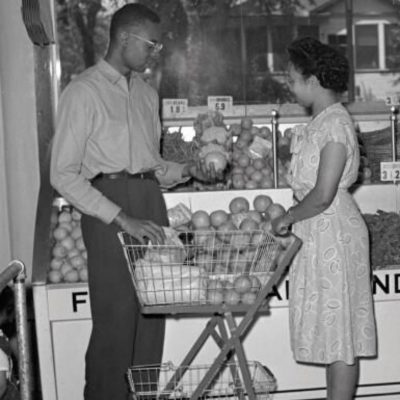
On an icy visit to Len Busch Roses (LBR) in Plymouth recently, there was a fizz and spark in the greenhouses.
“Everything builds up to this,” said Jason Lenz, LBR’s director of business development. “It doesn’t get any bigger than Valentine’s Day.”
Here at Seward Co-op, you’ve see Len Busch Roses’s flowers all year long—though maybe not quite so many as you’ll see in the next two weeks. Indeed, you may smell roses from the parking lot before you ever enter the store, we’ll have so many.
Sadly a good-smelling rose is a rarity in many American stores these days.
“Smell these,” Lenz said offering a bouquet of a dozen scarlet roses. He smiled as members of his tour took in the flowers’ scent. “Raspberries, right?”
Comparing LBR roses’ outstanding fragrance to inexpensive commodity roses from the giant rose-industry “farms” in South America isn’t really fair. Have you ever purchased a rose bouquet from a big-box grocer or garden store recently? The price is attractive, of course, but those flowers often have no appealing smell (if they open at all).
“Those roses have to travel all the way from Ecuador,” Lenz explained. “So they’ve been bred for hardiness and longevity, while that classic rose fragrance has just gone away, year by year.”
Sadly for a company with “Roses” in its name, LBR has watched its rose production diminish from 50,000 stems per year to 10,000–15,000 per year (due to their concentrating more on growing alstroemeria, gerbera daisies, tulips, tropicals, and ferns). Because the South American rose industry is so enormous, streamlined, and inexpensive, it puts huge pressure on smaller American producers like LBR to lower their prices.
“And now it’s Africa undercutting South America,” Lenz said, referring to titanic industries in South Africa and Kenya, which are even cheaper and have massive global reach. A rose can be cut in the morning in Kenya and appear in a British grocery that same night.
So how does a flower producer in Plymouth compete? Mainly by telling a story of sustainability and local pride. That’s why LBR is a P6 producer after all.
In 1965, founder Len Busch began his company by growing pom poms and then expanding to roses four years later. Though his son Patrick is CEO now, Len is still around.
“He comes in once a month to give us our beatings,” Lenz joked.
Since 1965, the company has grown to include over 500,000 square feet of greenhouses and an intricate steam system run on salvaged brush from local communities, chipped for two boilers that provide the steam (on this particular day, a line of gray-barked, brittle Christmas trees was ready to provide steam for the Valentine’s Day rose buds). This system provides over 90 percent of the energy needed at LBR.
With increased regulation on the floral industry, LBR has had to institute a rather involved IPM (integrated pest management) system, using spiders, wasps, and other beneficial insects to control mites that enter the greenhouses. LBR spends $25,000 a month on this system.
“Oh, yes, we take [sustainability] very seriously here,” Lenz said.
Today, the company employs 180 full-time workers who enjoy full benefits, and this stands as a stark contrast to South American and African flower companies, too. The global flower industry in third-world countries has frequently faced serious charges of abuse aimed at them, including: child labor violations, low pay, exposure to toxic pesticides and fungicides that have been banned in the U.S., firing injured or pregnant workers, etc. Meanwhile, longevity at Len Busch Roses in considerable.
“I started working here 27 years ago,” Lenz said, a little sheepishly. “Started when I was 15, went to college, then came back to get a job [here] in Plymouth. What can I say? It’s a great place to work.”
Paying a little extra for LBR roses than the commodity roses you’ll find at other stores makes a ton of sense. It’s not just an investment in your sweetheart, but also in the Earth, and for the greater good as well.
Seward Co-op’s Flowers and Plants from Len Busch Roses (Plymouth, MN)
Starting Thursday, February 12th, Seward Co-op will carry these flowers for Valentine’s Day.
Cuts
Gerbera Daisy – 3 stem bunches for $6.99
Alstroemeria – 10 stems for $12.99
Stargazer Lily – 2 stems for $7.99
Asiatic Lily – 3 stems for $7.99
Tulips – $9.99
Roses- 12 stems for $29.99
Snapdragons- $14.99
(We’ll also have Mixed Bouquets at various price points – but these are not totally local grown)
Potted Plants (locally grown; many of these aae in the store now!)
Cyclamen – 6-inch for $12.99
Kalonchoe- 6-inch for $12.99
Bulb gardens – 4-inch for $5.99/ large $12.99
Orchids – 4-inch for $23.99; 2-inch for $14.99
Azaleas – 6-inch for $21.99
Also from LBR (but not locally grown)
Jasmine wreaths (beautiful scent!)
Azalea trees
Many mixed bouquets
Single roses sleeved with greens
Half dozen rose bunches
Cut orchid bouquets
Read about this Saturday’s event Seward Co-op’s Valentine’s Day Sweetheart Sampler
Searching for a Valentine’s Day recipe? This one is a real keeper.
